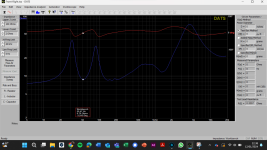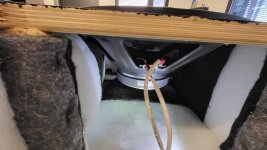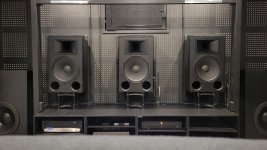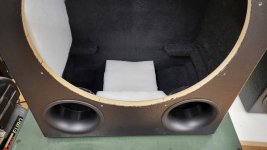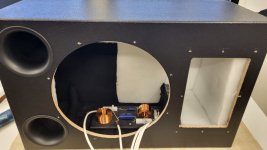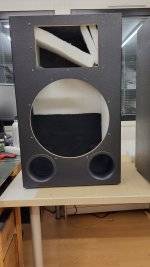Some quick and dirty counter measures can already help a lot: https://www.diyaudio.com/community/...708-ish-dimensioned-2-way.377634/post-7042753 More sophisticated approaches can do -20 dB.
If you feel it is a good place to discuss similar concepts, great! That said, if I knew about your speaker I would most likely have built that instead of these.We can certainly discuss this further here. It may also be of interest to other people.
Two 10 cm tubes with a length of 6 cm are ok. The bass reflex ports should be as large as possible for speakers with such high sound pressure levels.
If the cabinets are damped too much, bass reflex will not work properly. There should be no damping between the woofer and the port.
Maybe you can put the channels on the side, anything is better than the front.
Here you can see what is emitted from such a bass reflex port. Red is the driver, black is the port.
From around 400Hz, very strong interference comes out of the port, which has a very negative effect on the sound if it radiates directly towards the listener.
View attachment 1254018
Wooden houses and floating floors can vibrate strongly. They then act as absorbers and absorb bass. So this could very well be the reason for your problem.
Building ported speakers are more challenging than sealed. That's why I have build all sealed speakers. That said it seems in my space I might be better served by ported speakers. The lower output under 200 hz is affecting tonality and making the speakers sound too thin. These are crosses over to subs, but still...
1.For the Celestions: I will start with removing some stuffing.
My case is 75 liters and house the horn too. So actually liters are probably less than 75 and I have quite a bit of damping materials in there. Probably more than 2 Ikea pillows. The Asathor case is 95 and only house the bass driver. Might be it is overstuffed.
2.I will start to see where I can place the ports. On the sides are possible. Is there some suggestions as to where NOT have them? I remember some guidelines that you should no be able to see the driver through the port. The sides are 30 x 73 cm. The ports probably cannot fit there next to each other so they will have to be placed on top of each other, or one port per side. Any thoughts?
The openings should not be placed in the corner, as the cabinet walls will then extend the port inwards.
It is usually best to position the port at a third or two thirds of the height.
It is not wrong that the woofer should not be visible through the port. This means that no midrange sound can radiate directly from the back of the cone out of the port, but must first be reflected in the cabinet. This gives the damping material the opportunity to swallow the midrange.
I would place the ports on the left and right just below the magnet of the woofer.
I would attach the damping material along the walls. A thick layer that covers all the walls but still allows the ports inside to breathe freely.
The middle area of the speaker remains largely free of damping, but I would apply several layers above the horn and on the bottom.
I have made a small sketch of this:

Cover the side walls, just like the rear wall, with a layer. That should be enough.
It is usually best to position the port at a third or two thirds of the height.
It is not wrong that the woofer should not be visible through the port. This means that no midrange sound can radiate directly from the back of the cone out of the port, but must first be reflected in the cabinet. This gives the damping material the opportunity to swallow the midrange.
I would place the ports on the left and right just below the magnet of the woofer.
I would attach the damping material along the walls. A thick layer that covers all the walls but still allows the ports inside to breathe freely.
The middle area of the speaker remains largely free of damping, but I would apply several layers above the horn and on the bottom.
I have made a small sketch of this:
Cover the side walls, just like the rear wall, with a layer. That should be enough.
I will open them up this weekend. All my interior sidewalls are covered with a dense foam all ready. I might run into an issue where the bracing is right about there where the ports should go on the sidewalls. I assume that is why the original plans put them on the front.
This would of course not be ideal. Lets just say that it has been a very informative about building in general.
This would of course not be ideal. Lets just say that it has been a very informative about building in general.
I have now ported these Celestion boxes.
Despite the strong recommendation from @Rese66, I ported these on the front.
There is a couple of reasons for this:
1)I will most likely build a sort of baffle wall for these someday.(Then the ports has to be on the front)
2)I might even build the "big boy" boxes for these so I can compare them to these more compact version, so then these can be recycled.
3) Preserve my current bracing.
4) The original plans has them on the front.
That said, I will use the side porting for some smaller coaxial builds I have coming during this summer.
Subjectively these are noticeably more enjoyable to listen to now as the sound is much more balanced than it was before.
I really like these big speaker. The sense of ease, speed and power is very enjoyable and cannot image returning to smaller speakers.
Literally it feels that the elements can "breath". I pleased with the results.
This was the measurements over a average of 9 positions for the sealed 75 liters boxes:

This is with the same 9 positions but the ported boxes.

Impedance sweep for the front ported speakers.
I am total new with this DATS measurements,, but it seems that the the port might be slightly too short as the suggested tuning was for 55 hz and not 50hz.
Also that "little" bump at 200 hz seems to indicate some resonance that I should track down. I am not sure of it is a bracing issue or a damping issue.

I will most like add another layer of damping foam to separate the horn from the bass box.
See if that dampens that 205 hz resonance.

View attachment 1259284
Despite the strong recommendation from @Rese66, I ported these on the front.
There is a couple of reasons for this:
1)I will most likely build a sort of baffle wall for these someday.(Then the ports has to be on the front)
2)I might even build the "big boy" boxes for these so I can compare them to these more compact version, so then these can be recycled.
3) Preserve my current bracing.
4) The original plans has them on the front.
That said, I will use the side porting for some smaller coaxial builds I have coming during this summer.
Subjectively these are noticeably more enjoyable to listen to now as the sound is much more balanced than it was before.
I really like these big speaker. The sense of ease, speed and power is very enjoyable and cannot image returning to smaller speakers.
Literally it feels that the elements can "breath". I pleased with the results.
This was the measurements over a average of 9 positions for the sealed 75 liters boxes:
This is with the same 9 positions but the ported boxes.
Impedance sweep for the front ported speakers.
I am total new with this DATS measurements,, but it seems that the the port might be slightly too short as the suggested tuning was for 55 hz and not 50hz.
Also that "little" bump at 200 hz seems to indicate some resonance that I should track down. I am not sure of it is a bracing issue or a damping issue.
I will most like add another layer of damping foam to separate the horn from the bass box.
See if that dampens that 205 hz resonance.
View attachment 1259284
Attachments
Last edited:
If you want to increase the tuning frequency, the port must be shorter, i.e. the port is too long.I am total new with this DATS measurements,, but it seems that the the port might be slightly too short as the suggested tuning was for 55 hz and not 50hz.
By the way, the tuning frequency can be reduced slightly by adding damping material.
Best regards,
Michael
@Azrael Does it matter if the port tuning is slightly lower than expected? I added some damping but the tuning frequency stays the same. It did drop that bump in the impendance chart a bit too but that is also visible in the original plans too. Might be a driver resonance?
@Rese66, what is your design listening height? Looking at your plan the horisontal centre of the horn would most likely be at earheight (90cm?), maybe even a bit lower. Is that correct?
Where would the acoustical centre of such a large horn/ bassdriver be?
@Rese66, what is your design listening height? Looking at your plan the horisontal centre of the horn would most likely be at earheight (90cm?), maybe even a bit lower. Is that correct?
Where would the acoustical centre of such a large horn/ bassdriver be?
Dovrebbe funzionare bene con il tubo, ma non è adatto a volumi molto elevati.Chiedo a chiunque le abbia realizzate . Secondo voi possono suonare con un valvolare single ended con El 34 di circa 2/3 watt? Vi ringrazio
L'Alta Voce, ad esempio, sarebbe una scelta ancora migliore, perché è ancora più efficiente:
https://www.donhighend.de/?page_id=8971
- Home
- Loudspeakers
- Multi-Way
- Asathor - a JBL 4367 Clone
